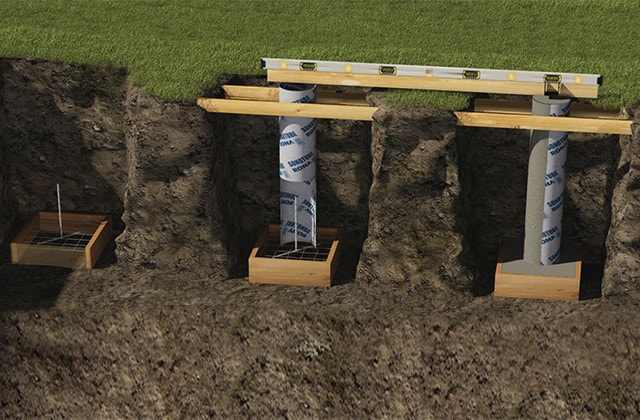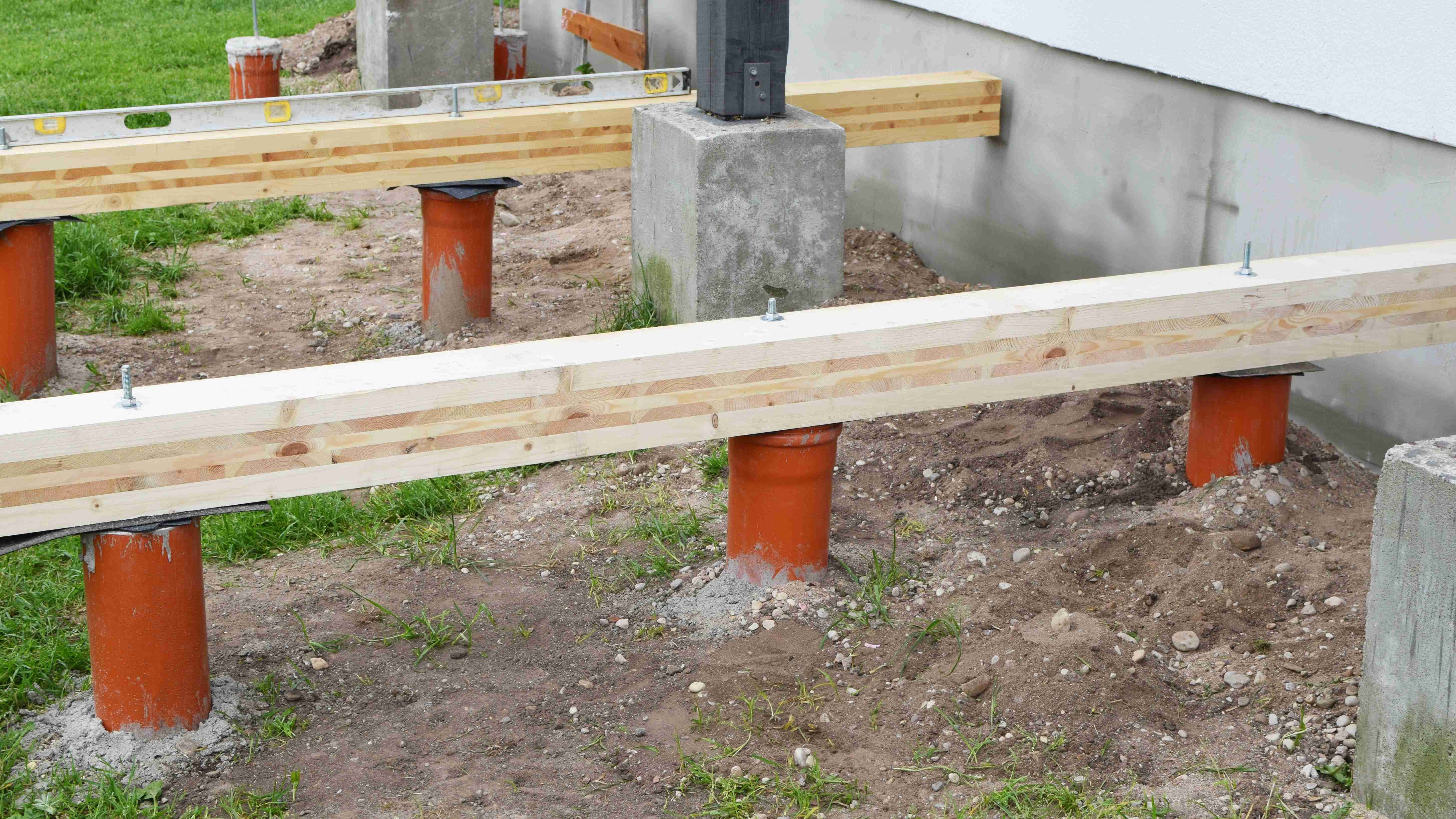Make Certain Security and Long Life With Appropriately Mounted Deck Grounds
Deck grounds may not be the most attractive aspect of deck construction, but they play a vital function in ensuring stability and longevity. In this discussion, we will check out the significance of proper deck footings, variables to consider throughout setup, different kinds of footings offered, step-by-step setup overview, and maintenance tips for making sure lasting grounds.

Relevance of Appropriate Deck Footings
Why are appropriately set up deck grounds critical for the security and long life of your deck? Deck grounds are the structure on which the deck relaxes, moving the lots from the deck to the ground.
To start with, properly installed deck footings distribute the weight of the deck evenly, avoiding any kind of irregular settling or sinking. This is specifically vital in areas with unpredictable dirt, as it aids to mitigate the risk of the deck shifting or breaking down. Furthermore, well-installed footings make sure that the deck continues to be degree, protecting against any structural damage that can happen when a deck comes to be irregular.
Second of all, appropriately set up footings supply a strong support for the deck, stopping too much activity and persuade. This helps to keep the structural integrity of the deck, reducing the threat of mishaps or injuries. It additionally reduces the wear and tear on the deck, enabling it to hold up against the aspects and regular use for a longer duration of time.
Factors to Take Into Consideration for Deck Footing Installment
When setting up deck grounds, there are a number of vital elements to take into consideration for appropriate installment. These aspects can significantly influence the stability and durability of your deck. First and foremost, you need to determine the kind of dirt on which the deck will be constructed. Different soil kinds have different load-bearing capabilities, so it is essential to perform a soil test to make certain the footings can support the weight of the deck and its owners. Furthermore, the area and layout of the deck must be meticulously planned to prevent any kind of obstacles such as trees, energy lines, or underground pipes. It is likewise vital to think about the neighborhood climate and climate conditions, as these can influence the sturdiness of the grounds. As an example, regions with a high water table might require extra actions to stop water damage. Last but not least, the size and material of the footings need to be chosen based on the dimension and weight of the deck, along with the local building codes and guidelines. By considering these factors, you can guarantee the appropriate setup of deck grounds and take pleasure in a stable and resilient deck.
Kinds Of Deck Grounds to Select From
There are numerous different sorts of deck grounds offered for you to select from. Each type has its very own advantages and disadvantages, so it's necessary to consider your specific demands and the conditions of your deck before making a choice.
One typical sort of deck footing is the concrete footing. This involves excavating openings in the ground and putting concrete right into them to produce a solid foundation. Concrete footings are durable and give outstanding stability, making them suitable for decks in locations with difficult soil problems or high wind lots.
One more option is the helical pier footing, which includes a steel shaft with helical plates that are screwed right into the ground. These footings are quick to install and can be used in numerous soil types, consisting of sandy or clay soils. They are also flexible, permitting easy progressing of the deck.
Sonotube footings are another preferred option. These grounds are produced by placing a cardboard tube in an opening and filling it with concrete. Sonotube grounds are fairly easy to mount and supply sufficient security for smaller decks or in areas with much less demanding dirt conditions.

When selecting the kind of deck ground, it's critical to take into consideration factors such as soil conditions, deck size and weight, regional building ordinance, and personal preferences. By choosing the ideal ground type, you can guarantee the stability and long life of your deck.
Step-by-Step Overview for Setting Up Deck Footings

Figure out the place: Begin by marking the exact position of each ground making use of stakes and string (Deck Footings). Take right into account any regional building regulations or policies relating to setback distances
Dig the openings: Make use of a message opening miner or an auger to dig the holes for the why not find out more footings. The depth will certainly rely on the frost line in your area and the sort of dirt. Generally, a depth of a minimum of 36 inches is advised for stability.
Level the holes: Make sure that all-time lows of the openings are level (Deck Footings). This can be accomplished by utilizing a degree or a straight board throughout the top of the openings
Include crushed rock: Area a layer of crushed rock at the bottom of each hole to improve drain and protect against the ground from penetrating the dirt with time.
Insert the footing forms: Place the ground creates right into the openings, guaranteeing they are focused and degree. Use stakes to protect them in position.
Mix and put concrete: Follow the instructions on the concrete mix bag to prepare the concrete. Pour the concrete right into the ground forms, filling them completely.
Smooth the surface: Use a trowel to smooth the surface of the concrete and remove any air pockets. Allow the concrete to cure according to the manufacturer's directions.
Maintenance Tips for Lasting Deck Footings
Proper upkeep is essential for ensuring the durability and security of deck footings. By routinely evaluating and maintaining your deck grounds, you can avoid damages and potential security hazards.
Routine cleansing is also necessary for maintaining deck grounds. Dirt, plants, and particles can accumulate around the footings, which can bring about moisture buildup and decay. Cleaning up the grounds routinely, utilizing a brush or a stress washer, can assist protect against these issues and prolong the life-span of your deck.
Along with cleansing, it is necessary to keep the area around the grounds free from any kind of blockages. Avoid stacking products against the grounds or permitting plants to expand also near them. These obstructions can trap moisture and cause the footings to weaken gradually.
Last but not least, regular resealing of the grounds is recommended here to safeguard them from wetness and various other ecological variables. Using a waterproof sealant can help prevent water damage and extend the life expectancy of the footings.
Verdict
In verdict, appropriate setup of deck footings is vital for making certain security and long life of your deck. Variables such as dirt kind, tons capability, and regional building regulations need to be thought about when selecting the best kind of deck footings. Following a step-by-step overview for installment and routine upkeep will help to ensure the footings continue to be durable and long lasting.
In this discussion, we will certainly discover the relevance of correct deck footings, factors to consider during installment, various types of footings available, detailed installment overview, and upkeep ideas for guaranteeing lasting footings. Deck grounds are the structure on which the deck relaxes, transferring the load from the deck to the ground.One common type of deck ground is the concrete ground. Insert the ground types: Insert the ground creates into the openings, ensuring they are centered and degree.In their website final thought, proper installation of deck grounds is important for ensuring security and long life of your deck.
Comments on “Engineered for Success: The Scientific Research Behind Durable and Resistant Deck Footings”